Abstract
A cross-sectional serological survey of domestic animals in West Malaysia revealed that 25.5% of the animals examined had agglutinating antibodies to one or more antigens belonging to Leptospira interrogans. Significant prevalence of infection was observed in cattle (40.5%), buffaloes (31%) and pigs (16%). The Sejroe serogroup was shown to be the principal one involved in cattle and buffaloes, and to a lesser extent the Tarassovi and Pomona serogroups. Evidence of infection in domestic animals by strains bearing the other seven antigens appeared insignificant and was indicative of sporadic infection. A majority of the large (semi-intensive) cattle and buffalo farms demonstrated a high prevalence of leptospiral infection. In both species of domestic animals mentioned above, the prevalence of infection was significantly higher (P = 0.01) in the semi-intensive farms than in the smallholdings. Amongst cattle, the droughtmasters had the highest prevalence whilst the Kedah-Kelantan (an indigenous breed) had the lowest prevalence of leptospiral infection. In general, the temperate breeds of cattle had a significantly (P = 0.01) higher prevalence of infection than local breeds. Leptospiral infection in goats and sheep was shown to be sporadic, and the Pomona serogroup was the principal leptospiral serogroup involved in these small ruminants. The prevalence of infection in pigs was observed to decline during the study period, and it is suspected that pigs in West Malaysia are the maintenance host for serovar pomona whilst cattle are the maintenance host for serovar hardjo. Overall, it appears that domestic animals in Malaysia will play a bigger role in the epidemiology of leptospiral infection with the advent of sophisticated farming.
Full text
PDF
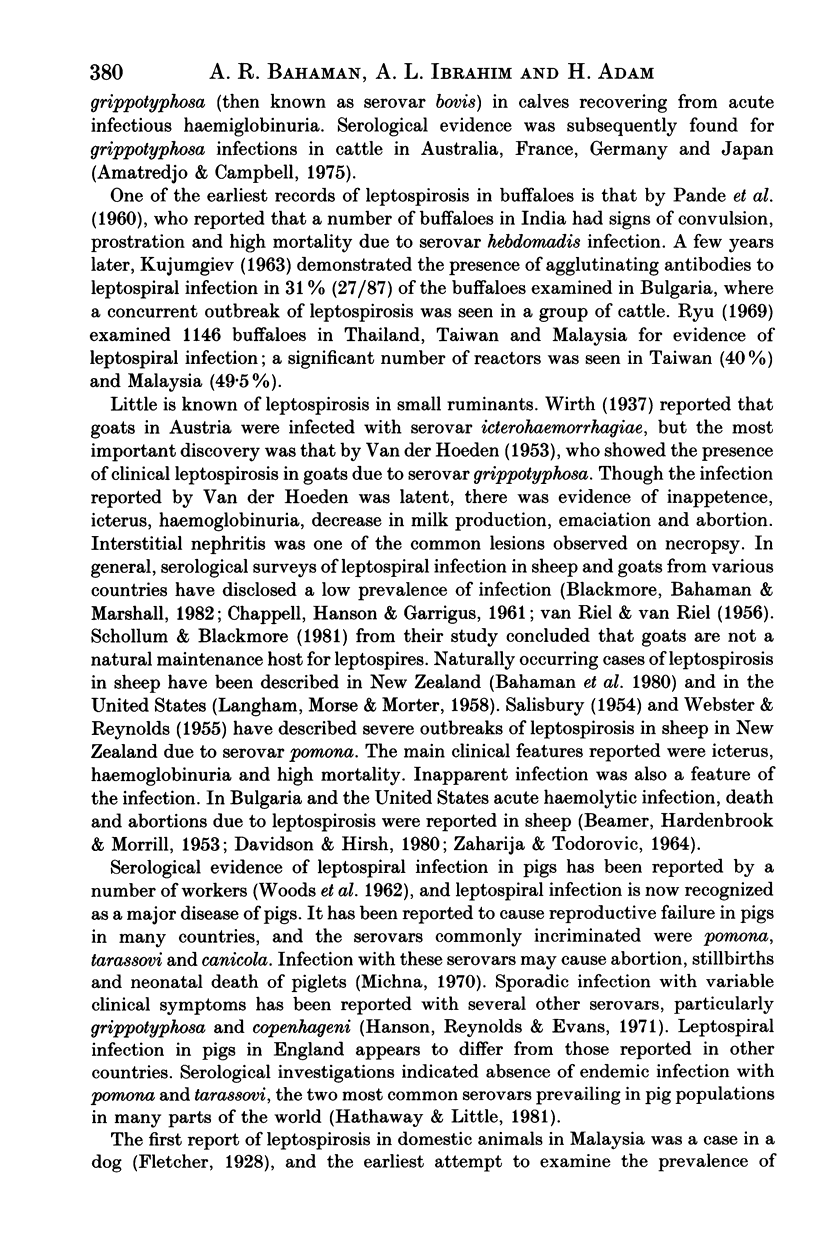
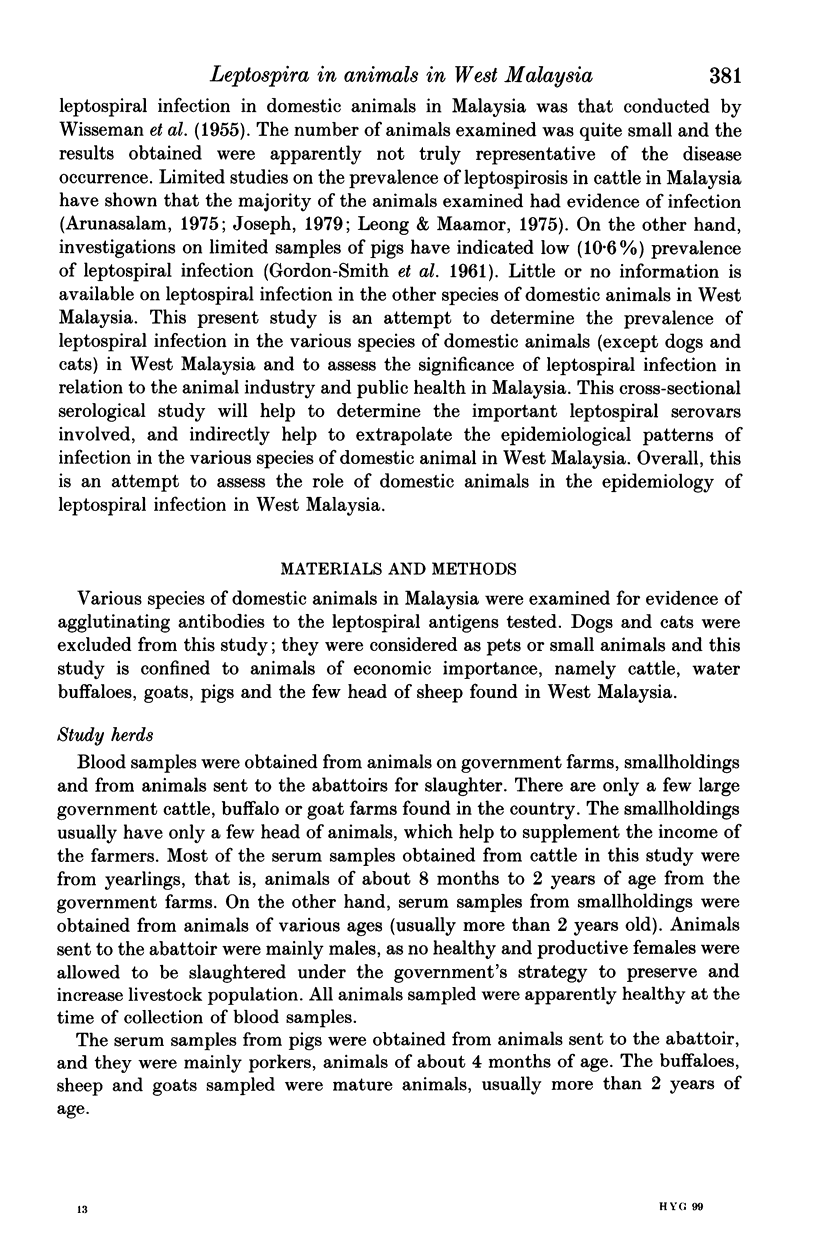
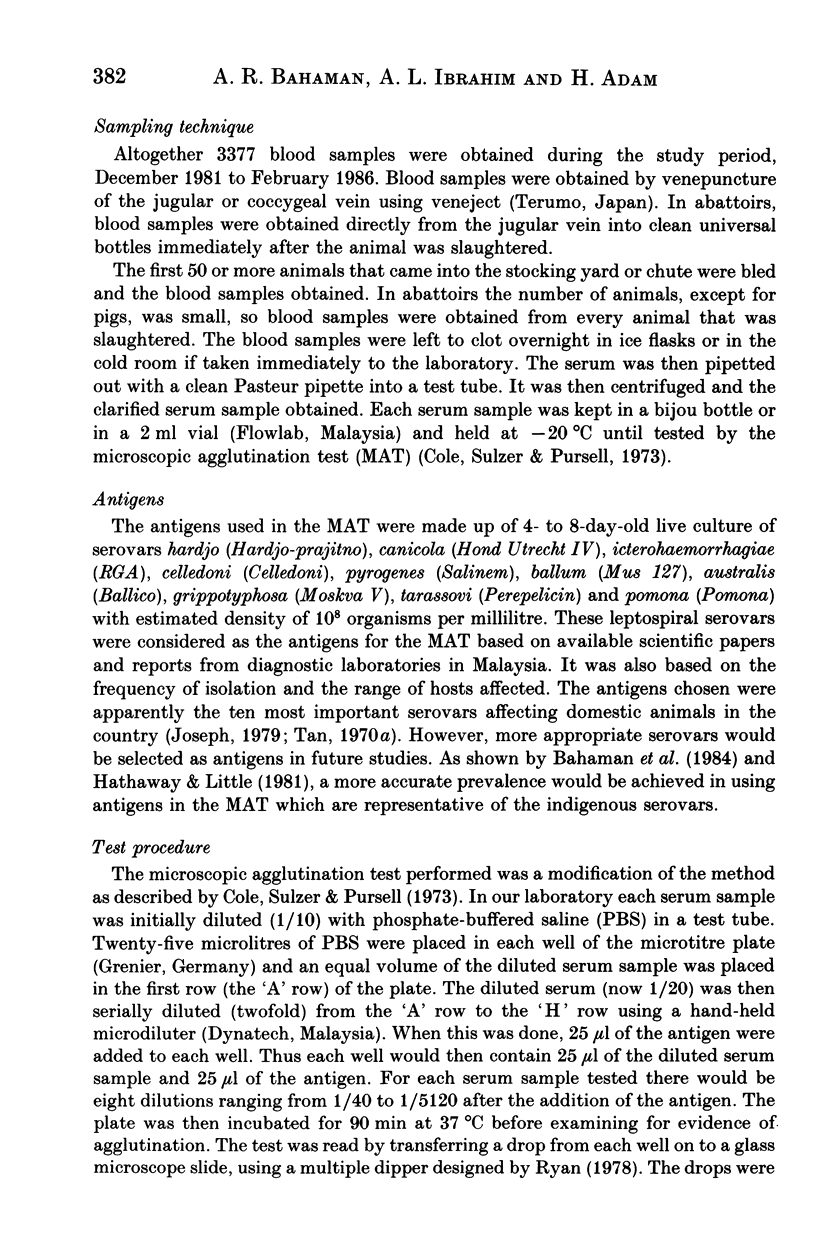
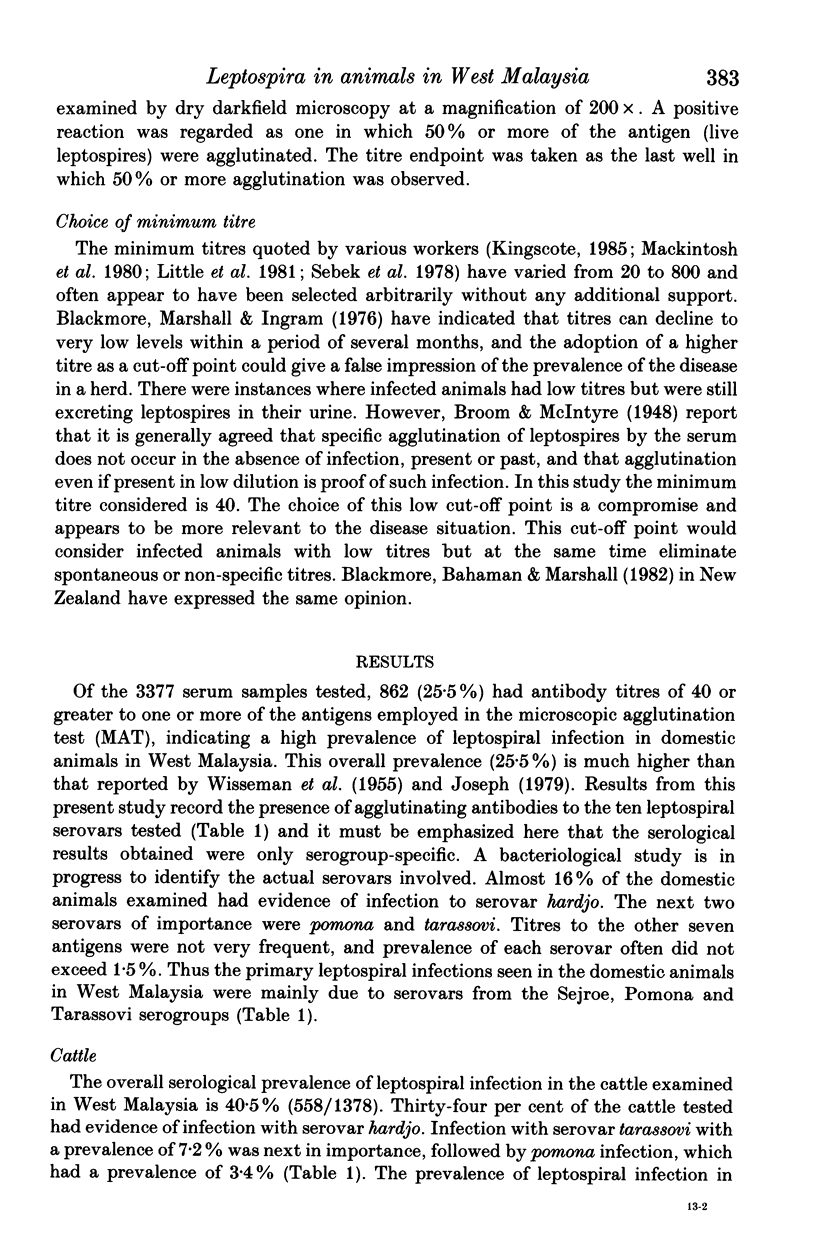
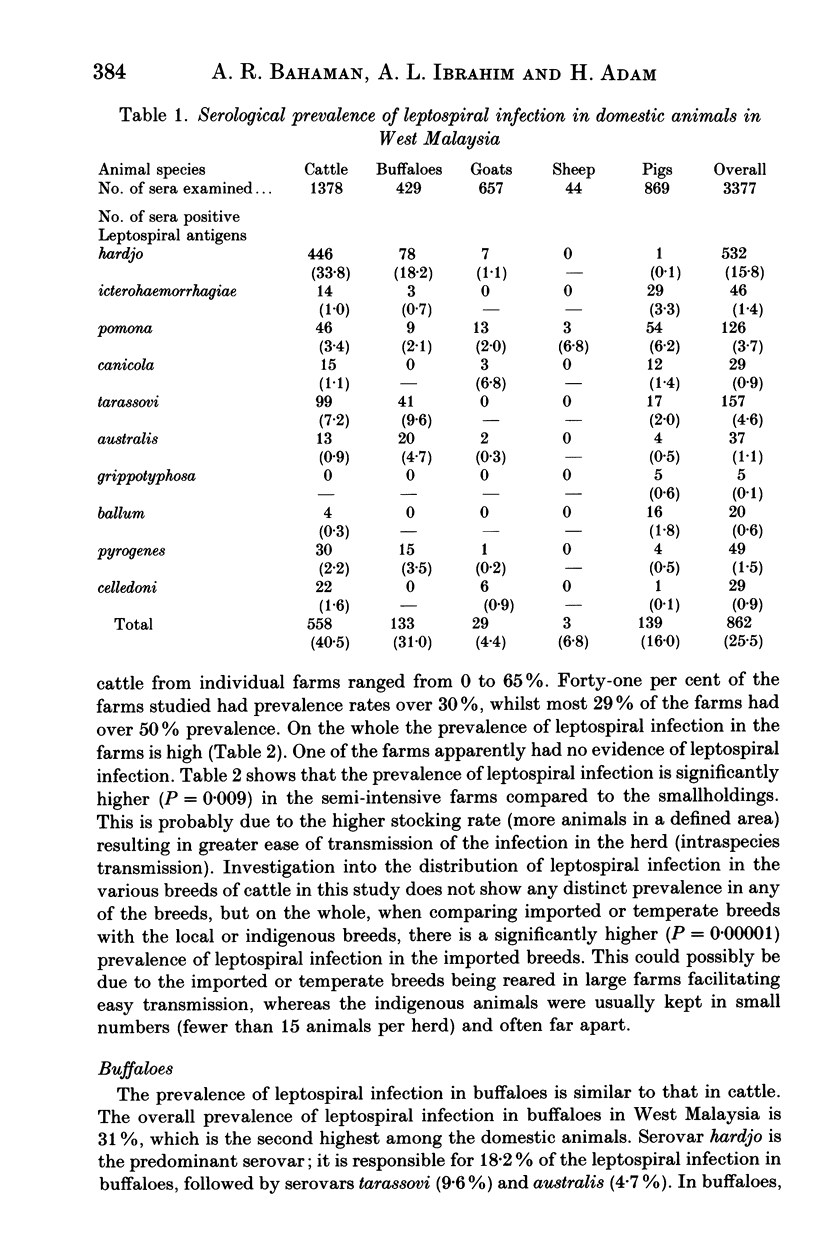
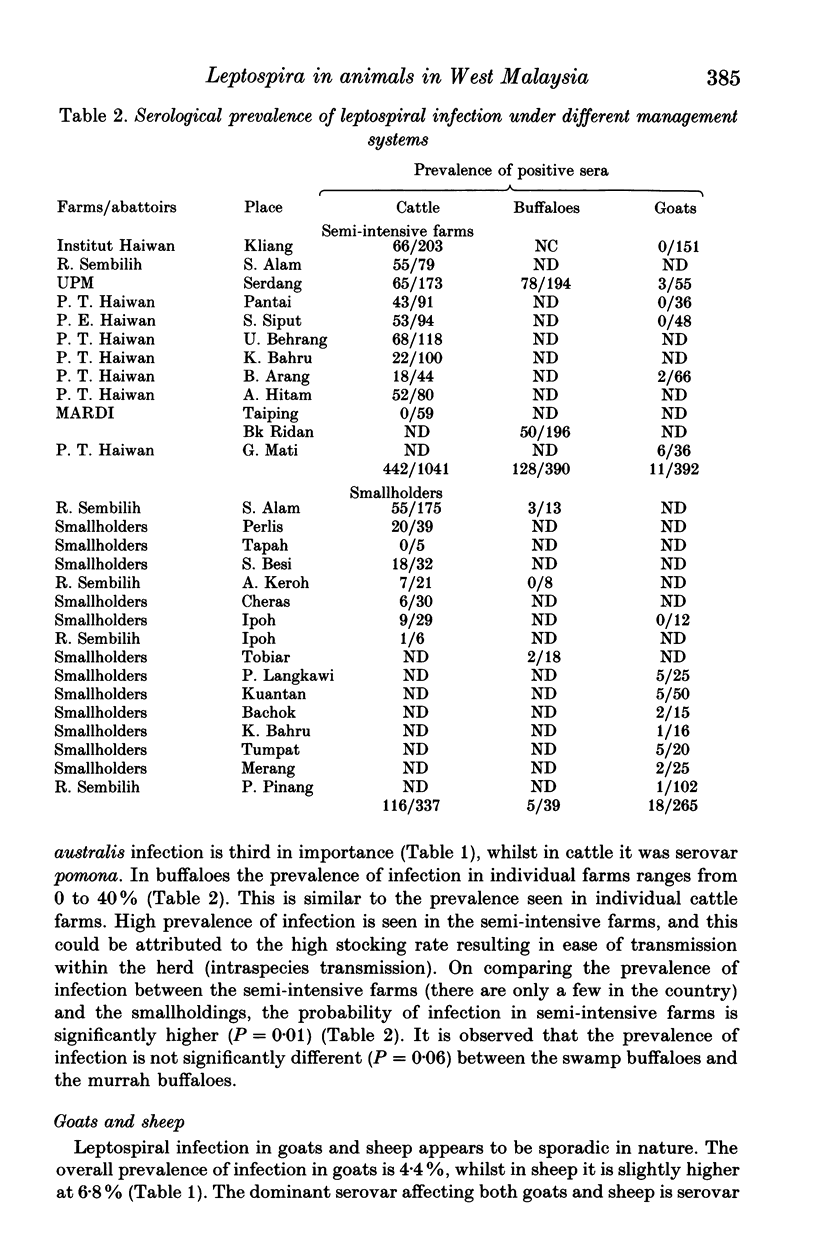
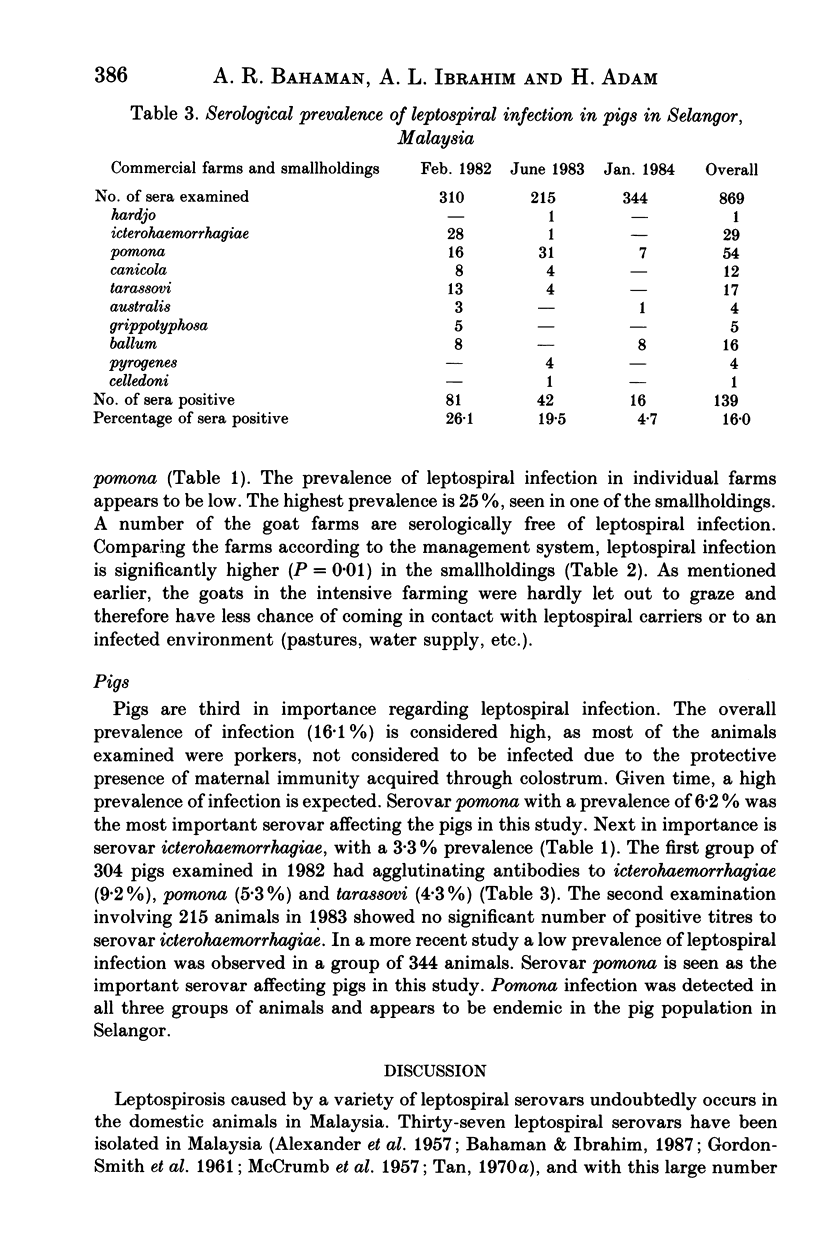
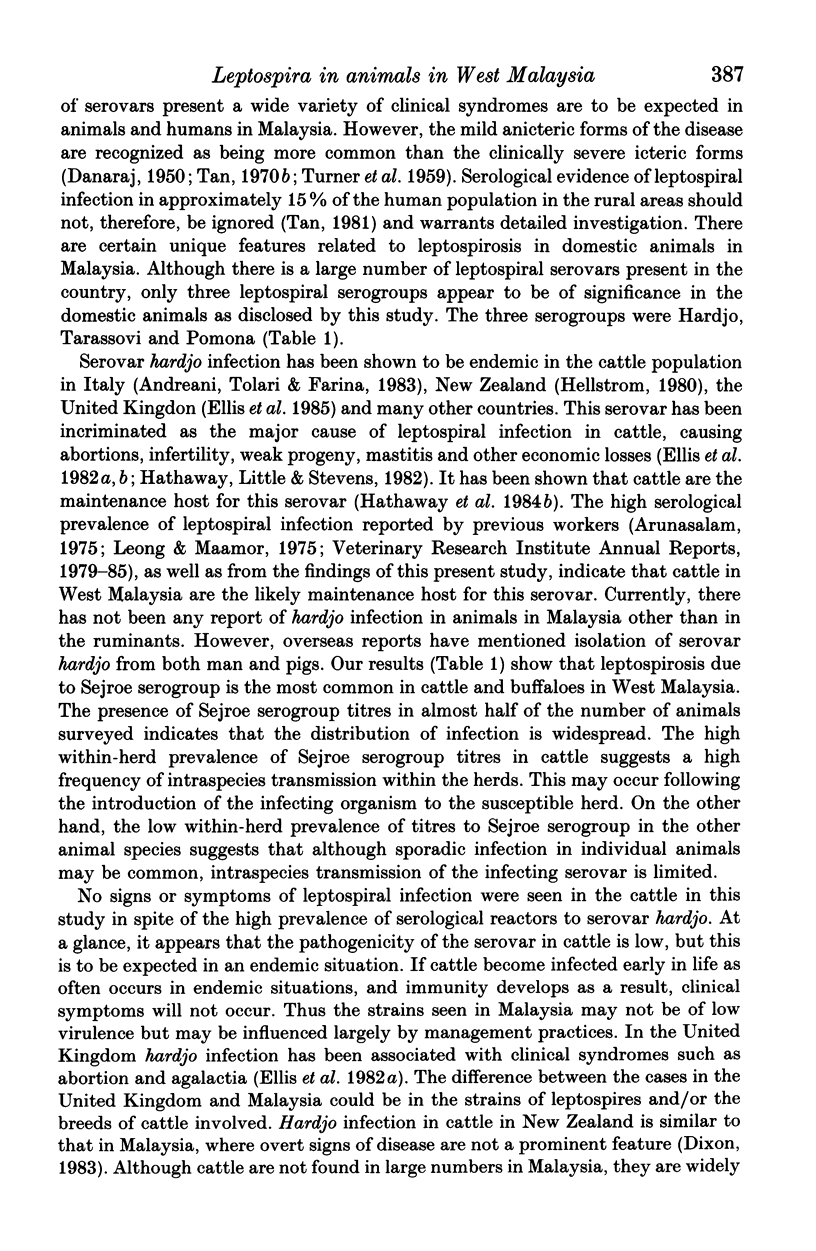
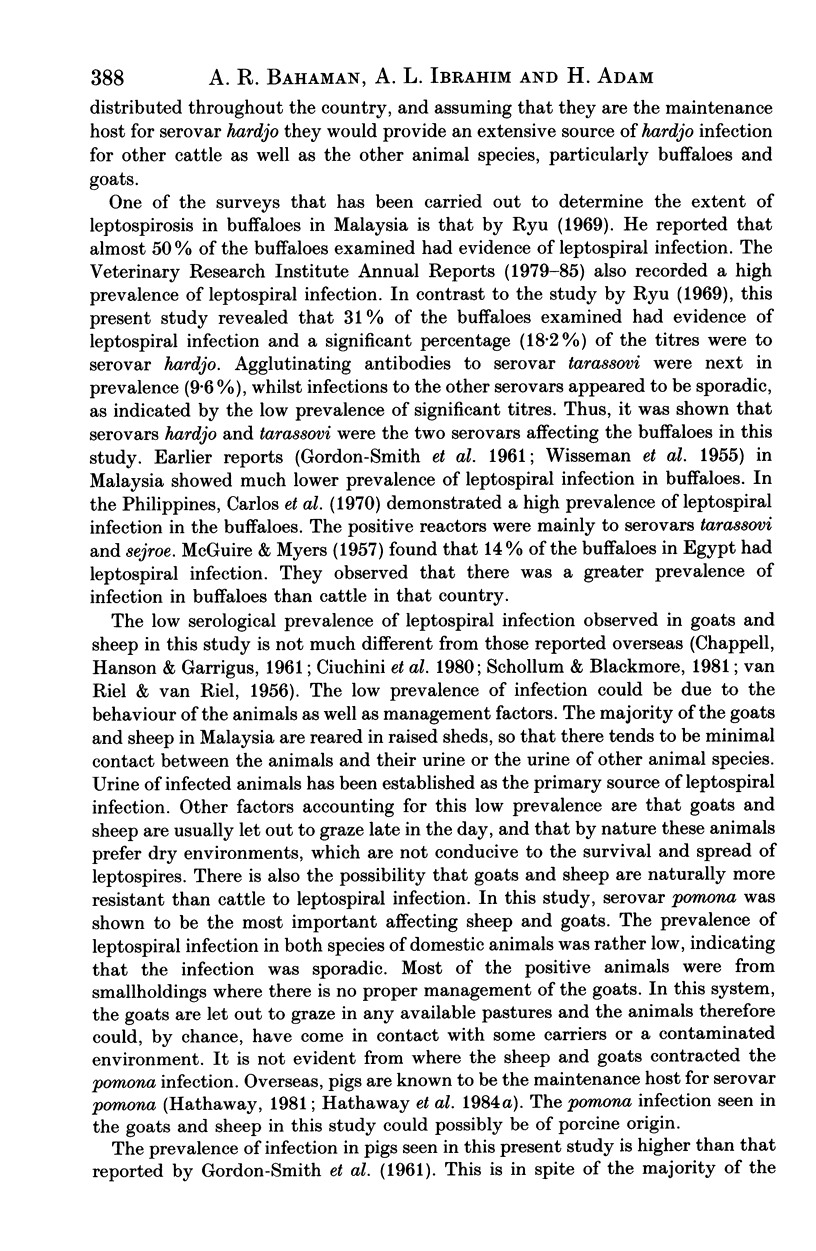
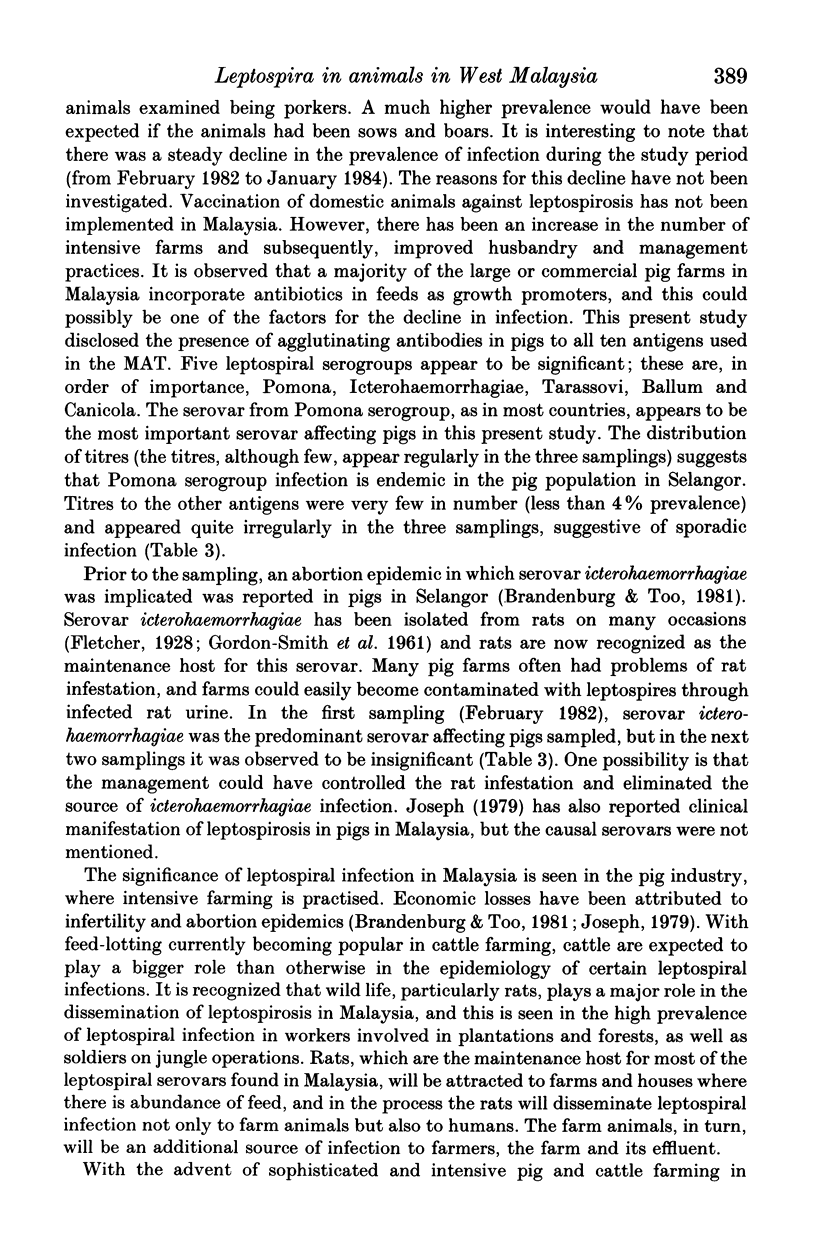
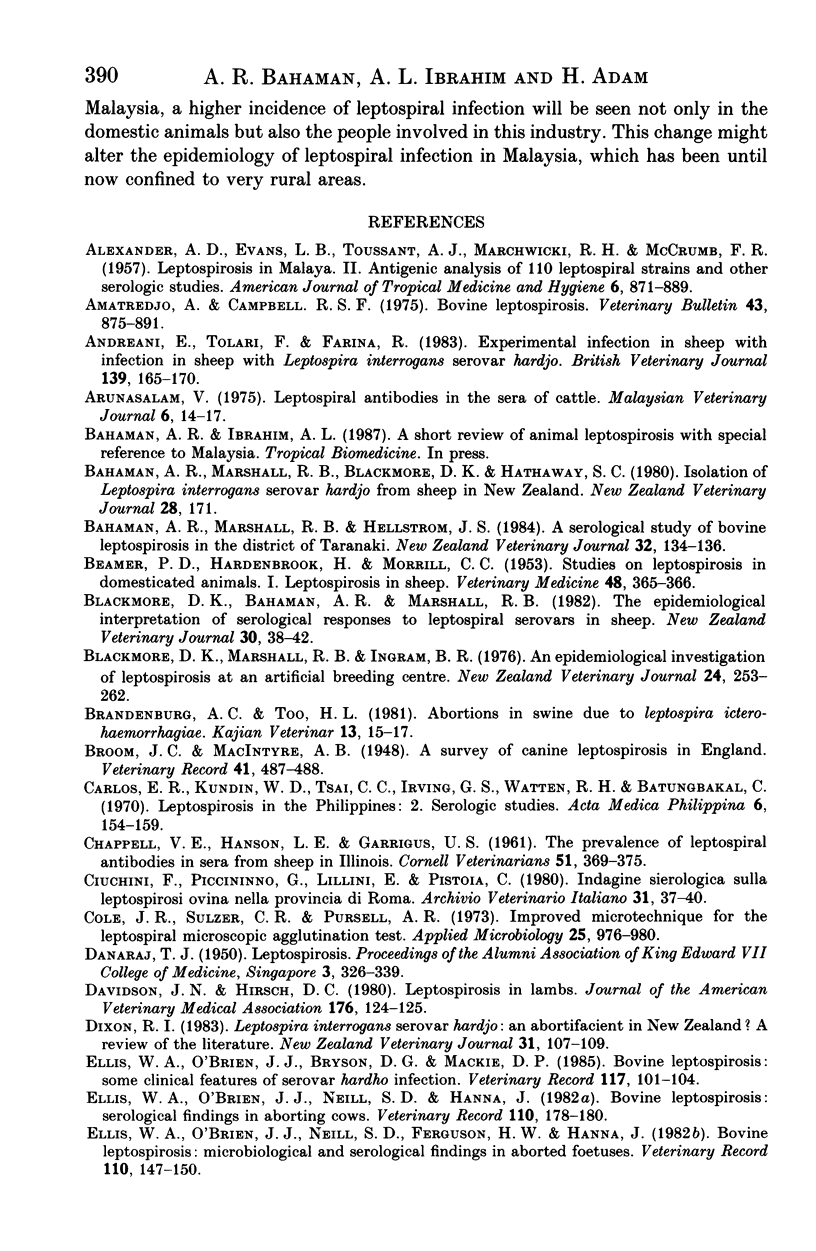
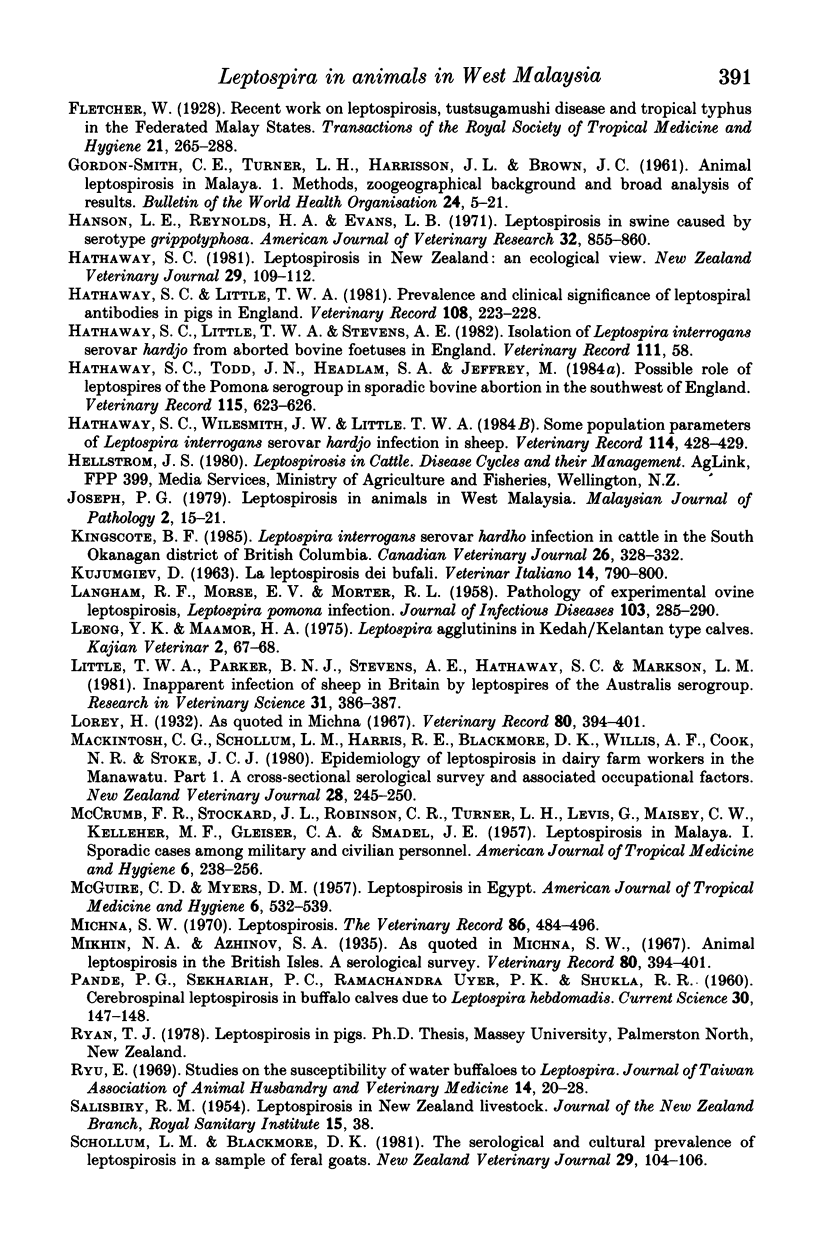
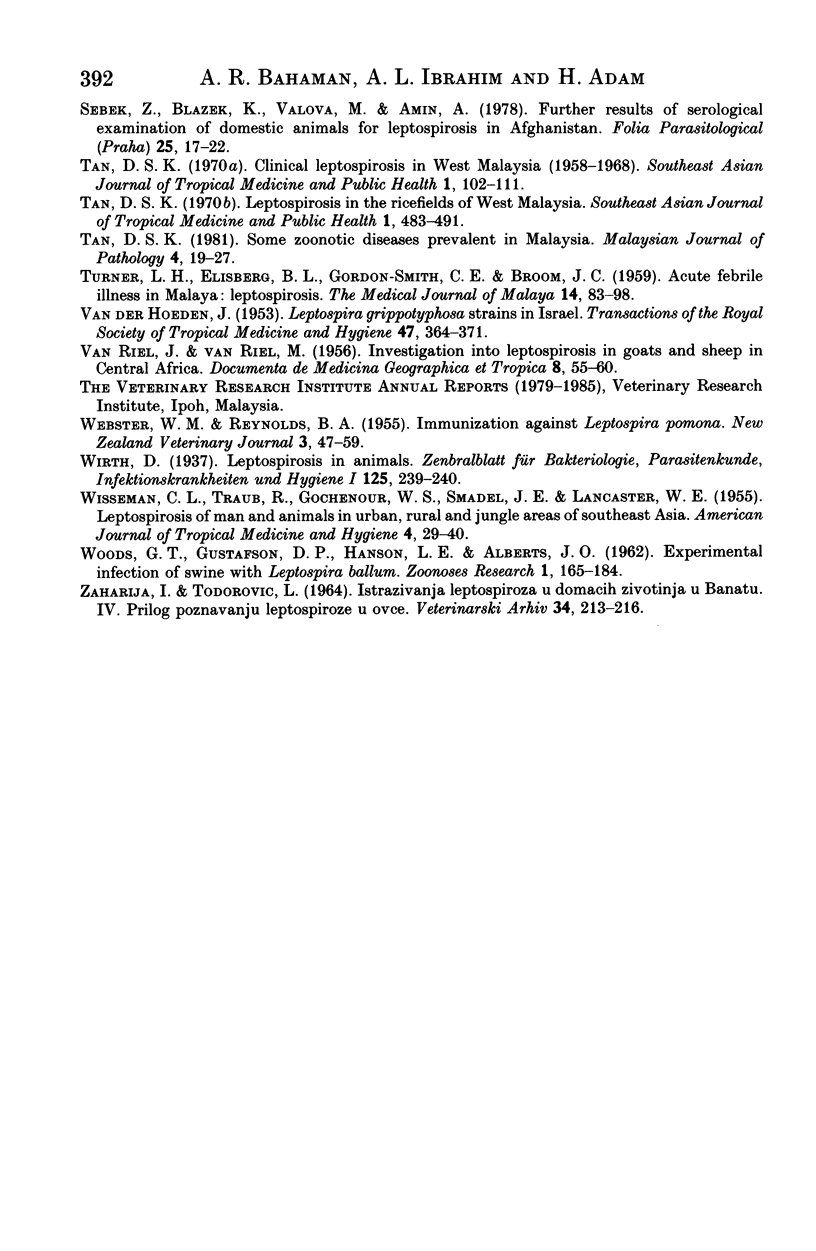
Selected References
These references are in PubMed. This may not be the complete list of references from this article.
- ALEXANDER A. D., EVANS L. B., TOUSSAINT A. J., MARCHWICKI R. H., McCRUMB F. R., Jr Leptospirosis in Malaya. II. Antigenic analysis of 110 leptospiral strains and other serologic studies. Am J Trop Med Hyg. 1957 Sep;6(5):871–889. [PubMed] [Google Scholar]
- Andreani E., Tolari F., Farina R. Experimental infection in sheep with Leptospira interrogans serotype hardjo. Br Vet J. 1983 Mar-Apr;139(2):165–170. doi: 10.1016/s0007-1935(17)30540-7. [DOI] [PubMed] [Google Scholar]
- Bahaman A. R., Marshall R. B., Hellstrom J. S. A serological study of bovine leptospirosis in the district of Taranaki. N Z Vet J. 1984 Aug;32(8):134–136. doi: 10.1080/00480169.1984.35096. [DOI] [PubMed] [Google Scholar]
- Blackmore D. K., Bahaman A. R., Marshall R. B. The epidemiological interpretation of serological responses to leptospiral serovars in sheep. N Z Vet J. 1982 Apr;30(4):38–42. doi: 10.1080/00480169.1982.34873. [DOI] [PubMed] [Google Scholar]
- Blackmore D. K., Marshall R. B., Ingram B. R. An epidemiological investigation of leptospirosis at an artifical breeding centre. N Z Vet J. 1976 Nov;24(11):253–262. doi: 10.1080/00480169.1976.34333. [DOI] [PubMed] [Google Scholar]
- Cole J. R., Jr, Sulzer C. R., Pursell A. R. Improved microtechnique for the leptospiral microscopic agglutination test. Appl Microbiol. 1973 Jun;25(6):976–980. doi: 10.1128/am.25.6.976-980.1973. [DOI] [PMC free article] [PubMed] [Google Scholar]
- Davidson J. N., Hirsh D. C. Leptospirosis in lambs. J Am Vet Med Assoc. 1980 Jan 15;176(2):124–125. [PubMed] [Google Scholar]
- Dixon R. J. Leptospira interrogans serovar Hardjo: an abortifacient in New Zealand? A review of the literature. N Z Vet J. 1983 Jul;31(7):107–109. doi: 10.1080/00480169.1983.34986. [DOI] [PubMed] [Google Scholar]
- Ellis W. A., O'Brien J. J., Bryson D. G., Mackie D. P. Bovine leptospirosis: some clinical features of serovar hardjo infection. Vet Rec. 1985 Aug 3;117(5):101–104. doi: 10.1136/vr.117.5.101. [DOI] [PubMed] [Google Scholar]
- Ellis W. A., O'Brien J. J., Neill S. D., Ferguson H. W., Hanna J. Bovine leptospirosis: microbiological and serological findings in aborted fetuses. Vet Rec. 1982 Feb 13;110(7):147–150. doi: 10.1136/vr.110.7.147. [DOI] [PubMed] [Google Scholar]
- Ellis W. A., O'Brien J. J., Neill S. D., Hanna J. Bovine leptospirosis: serological findings in aborting cows. Vet Rec. 1982 Feb 20;110(8):178–180. doi: 10.1136/vr.110.8.178. [DOI] [PubMed] [Google Scholar]
- Hanson L. E., Reynolds H. A., Evans L. B. Leptospirosis in swine caused by serotype grippotyphosa. Am J Vet Res. 1971 Jun;32(6):855–860. [PubMed] [Google Scholar]
- Hathaway S. C. Leptospirosis in New Zealand: an ecological view. N Z Vet J. 1981 Jul;29(7):109–112. doi: 10.1080/00480169.1981.34815. [DOI] [PubMed] [Google Scholar]
- Hathaway S. C., Little T. W. Prevalence and clinical significance of leptospiral antibodies in pigs in England. Vet Rec. 1981 Mar 14;108(11):224–228. doi: 10.1136/vr.108.11.224. [DOI] [PubMed] [Google Scholar]
- Hathaway S. C., Little T. W., Stevens A. E. Isolation of Leptospira interrogans serovar hardjo from aborted bovine fetuses in England. Vet Rec. 1982 Jul 17;111(3):58–58. doi: 10.1136/vr.111.3.58-a. [DOI] [PubMed] [Google Scholar]
- Hathaway S. C., Todd J. N., Headlam S. A., Jeffrey M. Possible role of leptospires of the Pomona serogroup in sporadic bovine abortion in the south west of England. Vet Rec. 1984 Dec 15;115(24):623–626. doi: 10.1136/vr.115.24.623. [DOI] [PubMed] [Google Scholar]
- Hathaway S. C., Wilesmith J. W., Little T. W. Some population parameters of Leptospira interrogans serovar hardjo infection in sheep. Vet Rec. 1984 Apr 28;114(17):428–429. doi: 10.1136/vr.114.17.428. [DOI] [PubMed] [Google Scholar]
- Joseph P. G. Leptospirosis in animals in West Malaysia. Malays J Pathol. 1979 Aug;2:15–21. [PubMed] [Google Scholar]
- Kingscote B. F. Leptospira interrogans serovar hardjo Infection in Cattle in the South Okanagan District of British Columbia. Can Vet J. 1985 Oct;26(10):328–332. [PMC free article] [PubMed] [Google Scholar]
- LANGHAM R. F., MORSE E. V., MORTER R. L. Pathology of experimental ovine leptospirosis, Leptospira pomona infection. J Infect Dis. 1958 Nov-Dec;103(3):285–290. doi: 10.1093/infdis/103.3.285. [DOI] [PubMed] [Google Scholar]
- Little T. W., Parker B. N., Stevens A. E., Hathaway S. C., Markson L. M. Inapparent infection of sheep in Britain by leptospires of the Australis serogroup. Res Vet Sci. 1981 Nov;31(3):386–387. [PubMed] [Google Scholar]
- MCCRUMB F. R., Jr, STOCKARD J. L., ROBINSON C. R., TURNER L. H., LEVIS D. G., MAISEY C. W., KELLEHER M. F., GLEISER C. A., SMADEL J. E. Leptospirosis in Malaya. I. Sporadic cases among military and civilian personnel. Am J Trop Med Hyg. 1957 Mar;6(2):238–256. [PubMed] [Google Scholar]
- MCGUIRE C. D., MYERS D. M. Leptospirosis in Egypt. Am J Trop Med Hyg. 1957 May;6(3):532–539. doi: 10.4269/ajtmh.1957.6.532. [DOI] [PubMed] [Google Scholar]
- Mackintosh C. G., Schollum L. M., Harris R. E., Blackmore D. K., Willis A. F., Cook N. R., Stoke J. C. Epidemiology of leptospirosis in dairy farm workers in the Manawatu. Part I: A cross-sectional serological survey and associated occupational factors. N Z Vet J. 1980 Dec;28(12):245–250. doi: 10.1080/00480169.1980.34769. [DOI] [PubMed] [Google Scholar]
- Michna S. W. Animal leptospirosis in the British Isles. A serological survey. Vet Rec. 1967 Apr 1;80(13):394–401. doi: 10.1136/vr.80.13.394. [DOI] [PubMed] [Google Scholar]
- Michna S. W. Leptospirosis. Vet Rec. 1970 Apr 25;86(17):484–496. doi: 10.1136/vr.86.17.484. [DOI] [PubMed] [Google Scholar]
- Schollum L. M., Blackmore D. K. The serological and cultural prevalence of leptospirosis in a sample of feral goats. N Z Vet J. 1981 Jun;29(6):104–106. doi: 10.1080/00480169.1981.34813. [DOI] [PubMed] [Google Scholar]
- Sebek Z., Blazek K., Valová M., Amin A. Further results of serological examination of domestic animals for leptospirosis in Afghanistan. Folia Parasitol (Praha) 1978;25(1):17–22. [PubMed] [Google Scholar]
- TURNER L. H., ELISBERG B. L., SMITH C. E., BROOM J. C. Acute febrile illnesses in Malaya: leptospirosis. Med J Malaya. 1959 Dec;14:83–98. [PubMed] [Google Scholar]
- Tan D. S. Some zoonotic diseases prevalent in Malaysia. Malays J Pathol. 1981 Aug;4:19–27. [PubMed] [Google Scholar]
- VAN DER HOEDEN J. Leptospira grippotyphosa strains in Israel. Trans R Soc Trop Med Hyg. 1953 Sep;47(5):364–371. doi: 10.1016/s0035-9203(53)80017-9. [DOI] [PubMed] [Google Scholar]
- VAN RIEL J., VAN RIEL M. Investigation into leptospirosis in goats and sheep in Central Africa. Doc Med Geogr Trop. 1956 Mar;8(1):55–60. [PubMed] [Google Scholar]
- WISSEMAN C. L., Jr, TRAUB R., GOCHENOUR W. S., Jr, SMADEL J. E., LANCASTER W. E. Leptospirosis of man and animals in urban, rural and jungle areas of southeast Asia. Am J Trop Med Hyg. 1955 Jan;4(1):29–40. doi: 10.4269/ajtmh.1955.4.29. [DOI] [PubMed] [Google Scholar]
- WOODS G. T., GUSTAFSON D. P., HANSON L. E., ALBERTS J. O. Experimental infection of swine with Leptospira ballum. Zoonoses Res. 1962 Apr 20;1:165–184. [PubMed] [Google Scholar]


